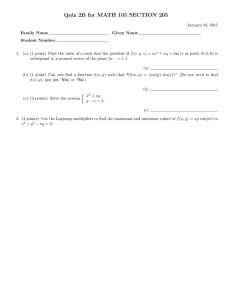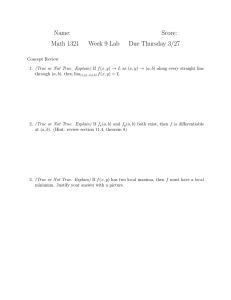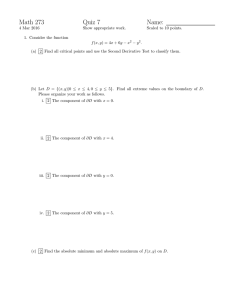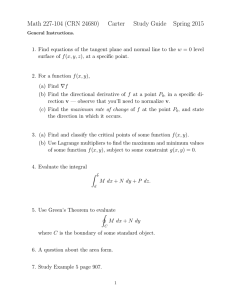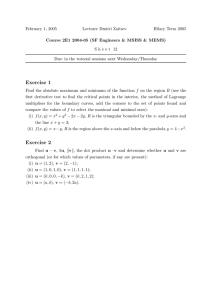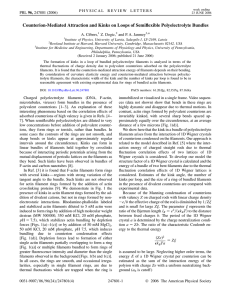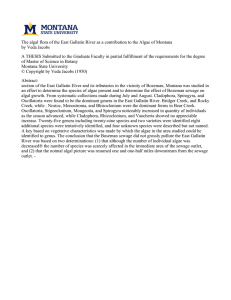Small Membrane Deformations on Surfaces Graham Hobbs
advertisement
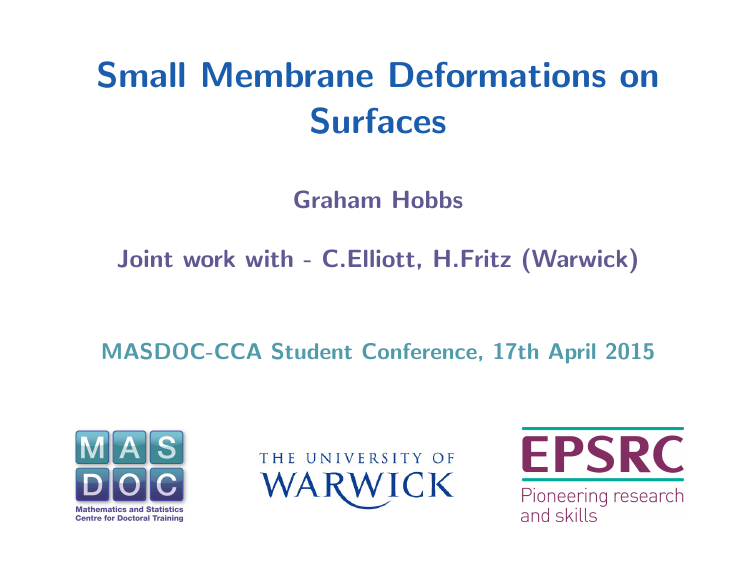
Small Membrane Deformations on
Surfaces
Graham Hobbs
Joint work with - C.Elliott, H.Fritz (Warwick)
MASDOC-CCA Student Conference, 17th April 2015
Contents
Introduction
Derivation of Energy Functional
Point Constraints
Further Work
Biomembranes
Biomembranes are composed of phospholipid molcules, built from
a hydrophilic phosphate ’head’ and a hydrophobic lipid ’tail’.
When immersed in water they form structures in which the heads
point towards the water and the tails away. Biomembranes are
composed of one such structure, the bilayer sheet.
-Hydrophillic Head
-Hydrophobic Tail
Biomembrane Deformation - Actin Filaments
Biomembrane deformation can be caused by the action of exterior
proteins. Actin filaments push against the membrane and cause it
to bend.
-Membrane Bending
Force applied by actin filaments
Modelling Assumptions
I
The membrane is a single elastic sheet and may be represented
by a small deformation of a given surface Γ ⊂ R3 .
I
Actin filaments are modelled as single points.
I
Filaments may apply a point constraint to h or apply a point
force to the membrane.
I
The energy due to the curvature of the membrane is given by
the Willmore energy functional.
Willmore Energy Functional
We consider the Willmore energy functional with surface tension
given by
Z
1
κH 2 + σ do.
W(Γ) :=
2 Γ
I
κ > 0 is the bending modulus.
I
σ > 0 accounts for the surface tension.
We wish to minimise this energy over some appropriate set of
surfaces Γ under volume and centre of mass constraints. The
constraints will be introduced via Lagrange multipliers.
Volume and Centre of Mass
Assuming Γ = ∂Ω, where Ω ⊂ R3 is a bounded domain, the
volume and centre of mass are given by
Z
Z
1
X · ν do and C (Γ) := X do.
V (Γ) :=
3 Γ
Γ
Introducing Lagrange multipliers yields the energy functional
J (Γ, λ, v ) = W(Γ) + λ(V (Γ) − V0 ) + v · (C (Γ) − C0 ).
The multipliers λ ∈ R, v ∈ R3 will be fixed later.
Possible Deformed Surfaces
We assume that the deformed surfaces are small deformations of a
given surface Γ ⊂ R3 of the form
Γε,h = {X + εh(X )ν(X ) | X ∈ Γ}
where 0 < ε 1 and h : Γ → R is sufficiently smooth.
Performing O(ε) variations around the Lagrange multipliers also
we obtain the functional
J (ε; h, µ, w ) := J (Γε,h , λ + εµ, v + εw ).
Minimising this energy over (h, µ, w ) ∈ V × R × R3 is equivalent
to minimising W over {Γε,h | h ∈ V , V (Γε,h ) = V0 , C (Γε,h ) = C0 }.
Linearisation
For each h, µ, w consider the Taylor expansion
dJ (ε; h, µ, w ) J (ε; h, µ, w ) =J (0; h, µ, w ) + ε
dε
ε=0
ε2 d2 J (ε; h, µ, w ) + O(ε3 ).
+
2
dε2
ε=0
I
J (0; h, µ, w ) = W(Γ) is a constant.
I
We may choose λ, v such that the first variation vanishes.
I
As ε is small we discard the O(ε3 ) term.
Linearisation
We are left with the second variation term.
d2 J (ε; h, µ, w ) J(h, µ, w ) =
dε2
ε=0
=W 00 (Γ)[hν, hν] + λV 00 (Γ)[hν, hν] + v · C 00 (Γ)[hν, hν]
+ 2µV 0 (Γ)[hν] + 2w · C 0 (Γ)[hν]
We seek to minimise this over (h, µ, w ) ∈ K × R × R3 , where
K ⊂ H 2 (Γ) is a suitably chosen subset.
Application to a Sphere
Now take Γ = x ∈ R3 | |x| = R and fix the Lagrange multipliers
λ = −2σ/R, v = 0. The linearised energy functional becomes
Z
2σ
2κ
2
J(h, µ, w ) = κ(∆Γ h) + σ − 2 |∇Γ h|2 − 2 h2
R
R
Γ
+ (µ + 3w · ν)h do.
At a minimum we must have
∂J
0=
(h, µ, w ) =
∂µ
Z
h do,
ΓZ
0 = ∇w J(h, µ, w ) =
hν do.
Γ
Thus it is equivalent to minimise J(h, 0, 0) over
Z
Z
K̃ := h ∈ K 0 = h do = hνi do, i = 1, 2, 3 .
Γ
Γ
Fixed Heights Problem
We first consider filaments applying a point constraint to the
displacement h.
This corresponds to the action of actin filaments anchored to the
cytoskeleton.
Let N ∈ N and take X ∈ ΓN to be the inclusion locations. The
inclusions apply the point constraints
h(Xi ) = αi ∀1 ≤ i ≤ N
for some α ∈ RN .
We look to minimise J(h, 0, 0) over a subset of H 2 (Γ) subject to
these constraints.
Fixed Heights Problem
We put this minimisation problem into a general framework
developed previously.
Define V ⊂ H 2 (Γ) by
Z
Z
2
V := h ∈ H (Γ) 0 = h do = hνi do, i = 1, 2, 3 .
Γ
Γ
Define a : V × V → R by
Z
2σ
2κ
a(g , h) = κ∆Γ g ∆Γ h + σ − 2 ∇Γ g · ∇Γ h − 2 gh do.
R
R
Γ
Define a convex subset of V :
KαX := {v ∈ V | v (Xi ) = αi ∀1 ≤ i ≤ N} .
Abstract Quadratic Programming Problem
Theorem (Quadratic programming problem (QPP))
Let V be a Hilbert Space, fix N ∈ N, α ∈ RN and a set of
linearly independent functionals {F1 , ..., FN } ⊂ V ∗ . We thus define
a convex subset KαF ⊂ V by:
KαF := {v ∈ V | Fj (v ) = αj ∀ 1 ≤ j ≤ N} .
Let a : V × V → R be bilinear, symmetric, bounded and coercive.
Let l : V → R be a bounded linear functional.
Define J : V → R by J(v ) := 12 a(v , v ) − l(v ).
Then ∃!u ∈ KαF such that
J(u) ≤ J(v ) ∀ v ∈ KαF .
Checking assumptions
The assumptions we need to check are for the bilinear form
Z 2
a(g , h) = κ ∆Γ g ∆Γ h − 2 ∇Γ g · ∇Γ h
R
Γ
2
+ σ ∇Γ g · ∇Γ h − 2 gh do.
R
I
Bilinearity, boundedness and symmetry are clear.
I
We would like coercivity for any κ > 0, σ ≥ 0, this is not so
clear.
Poincaré to the Rescue?
R
As Γ h = 0 for each h ∈ V we may apply the Poincaré inequality
and integration by parts to obtain the inequalities
Z
(∆Γ h)2 do ≥ C khk2H 2 (Γ)
Γ
Z 2C 2 (Γ)
2C 2 (Γ)
(∆Γ h)2 + σ 1 − P 2
|∇Γ h|2
a(h, h) ≥ κ 1 − P 2
R
R
Γ
I
So we have the required coercivity provided CP2 (Γ) < R 2 /2.
I
For a sphere radius R, CP2 (Γ) = R 2 /2.
Optimal Poincaré Constant
In fact we may replace the Poincaré constant used above by the
optimal Poincaré constant over V , satisfying:
R
R
2 do
|∇Γ v |2 do
|∇
v
|
Γ
−2
CV = inf Γ R 2
≥ inf Γ R 2
= λ2
v ∈X
v ∈V
Γ v do
Γ v do
R
R
where X := h ∈ H 1 (Γ) | 0 = Γ h do = Γ hνi do, i = 1, 2, 3 and
λ2 is the second non-zero eigenvalue for the Laplace-Beltrami
operator.
I
λ2 = 6/R 2 thus CV2 = R 2 /6 < R 2 /2 and a is coercive over V .
Further Work
I
We can also show existence of global minimisers for the fixed
heights problem.
I
We can model point forces by studying the energy
N
X
1
a(v , v ) −
v→
7
βi h(Xi )
2
i=1
I
We can apply similar techniques to model inclusions applying
point curvature constraints.
